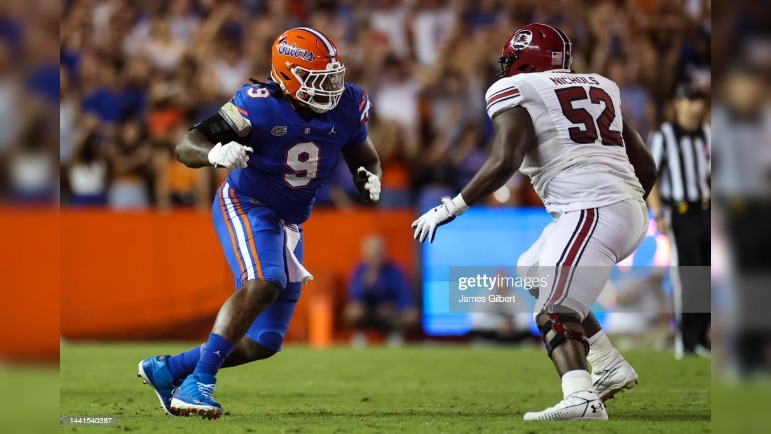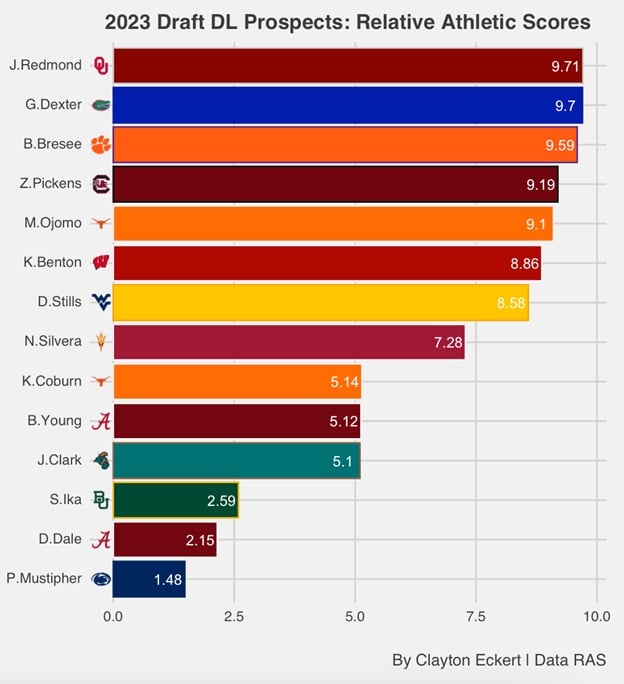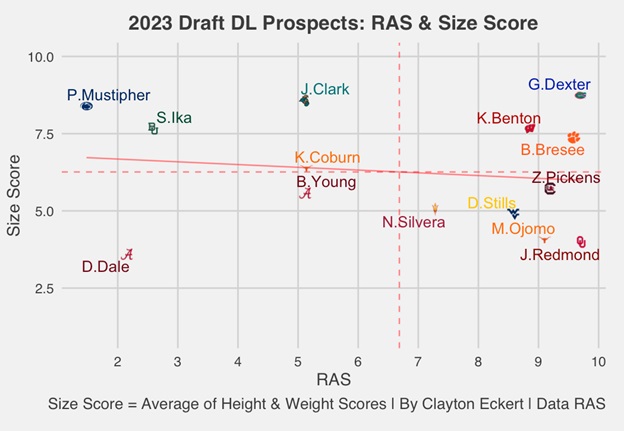Today I wanted to visualize some great data from Kent Lee Platt’s Relative Athletic Scores (RAS) for the defensive lineman. Here is a link to Platt’s website in case you haven’t seen his work https://ras.football/. To qualify for a RAS score, a player must have a total of six recorded metrics from any of the following: Height, Weight, 40-yard dash, 20-yard split, 10-yard split, Bench Press, Vertical Jump, Broad Jump, Short Shuttle, and 3-Cone. The player is then graded on each in comparison to the positional database since 1987 to get more of a feel of their size, speed, explosion, agility, and total value, giving context to the raw numbers.
The goal of the series is to provide the RAS from Platt, with a bit of my own twist with a size score and visualize it to get a simultaneous view of all the players at their position that participated at the combine. Here are the players that qualified for a RAS (NOTE: Positions are grouped from the combine results tracker compiled by Dave Bryan and Alex Kozora):
Five of the 14 qualifying prospects have a RAS of nine or above, starting with Oklahoma’s Jalen Redmond with a 9.71 RAS, who has elite speed and explosion, great agility, but poor size, with the highlight of his workout a 4.81 40-yard dash and weight (291) his lowest mark. Florida’s Gervon Dexter (9.7 RAS) who has elite speed, great size and explosion, but didn’t qualify in agility, with his best mark being his height (6055) and 22 reps on the bench his lowest. Clemson’s Bryan Bresee (9.59 RAS) has elite speed and agility, good size, but didn’t qualify in explosion, with his 1.65 10-yard split his best mark and 22 reps on the bench the lowest. South Carolina’s Zacch Pickens (9.19 RAS) who has elite speed, great explosion, good agility, and okay size, with a 908 broad his best mark and 22 reps on the bench the lowest. Moro Ojomo of Texas (9.1 RAS) has elite explosion, great speed, good agility, and poor size, with the highlight of his workout a 1.68 10-yard split and weighing 289 his lowest.
Two players had RAS scores in the eight range, starting with Wisconsin’s Keeanu Benton (8.86 RAS) who has good size, speed, explosion, and agility with his best result being a 7.34 3-cone and lowest a 2.95 20-yard split. West Virginia’s Dante Stills (8.58 RAS) has elite speed, good explosion and agility, and okay size, with the highlight of his workout a 4.82 40-yard dash and 20 reps on the bench his lowest.
Arizona State’s Nesta Jade Silvera is the only player with a RAS in the sevens (7.28), and has good speed and explosion, okay size, with no agility testing and his best mark a 902 broad jump and lowest result standing at 6’2”.
After a drop-off with no prospects in the six range, we see three players in the five RAS tier, starting with Keondre Coburn of Texas (5.14 RAS) who has good size and agility, okay speed, but poor explosion, weighing a solid 336 pounds but height being his lowest mark (6016). Alabama’s Byron Young (5.12 RAS) has okay size and explosion, didn’t qualify for agility and no speed testing, with his best result a 900 broad jump and lowest a 26” vertical. Coastal Carolina’s Jerrod Clark has great size, okay agility, but poor speed and explosion, weighing in solidly at 334, and his 4.83 short shuttle his low point.
Two players land within the two RAS range starting with Baylor’s Siaki Ika (2.59 RAS) who has good size, poor agility, very poor speed grade, and no explosiveness testing, with weight being his best result by far (335), and a 4.99 in the shuttle drill. Alabama’s DJ Dale (2.15 RAS) has okay agility, poor size and speed, and very poor explosion, with a 1.77 10-yard split and height (6007) hist lower mark.
The final player is Penn State’s P.J. Mustipher with a low 1.48 RAS, and has great size, but poor explosion and very poor speed and agility, with his weight (320) a better mark, and a historically low 5.03 shuttle that is outside Pittsburgh’s previous selections.
Next, I wanted to provide more context with a size score using the RAS for the players’ height and weight, which includes all the combine invites since all the players are measured:
Overall, there is less size at the position in this year’s draft than 2022, when five prospects had a RAS above nine compared to none in 2023. Dexter tops the list (6055, 310), pairing this with the second-ranked 9.7 overall RAS (0.01 shy of the top rank) along with elite speed, great size and explosion. Clark comes in second (6035, 334) but a much lower 5.1 overall RAS but low 5.25 40-yard dash that’s outside of Pittsburgh’s draft history at the position. The third-ranked prospect is Mustipher (6037, 320) but very important to recall his bottom-ranked total 1.48 RAS with his 800 broad jump, 5.41 40-yard dash, and 5.03 shuttle outside of the Steelers’ past draft thresholds.
Five players have size scores in the seven range (which is a good RAS rank), including Ika (6027, 335) with a 5.39 40-yard dash and 4.99 shuttle that are outside what the Steelers have typically looked for. Benton (6036, 309) and important to recall his solid workout numbers overall (8.86 RAS). Michigan’s Mazi Smith (6030, 323) didn’t qualify for an RAS, but did have a strong 34 reps on the bench, a 29.5 vertical, and 8’11 broad jump. Bresee (6054, 298) pairs his size with elite speed and agility for the third-ranked overall RAS, and comfortably fits what Pittsburgh looks for athletically. Georgia’s Jalen Carter measured in at 6030, 314 pounds, but didn’t test otherwise.
In the six range, there are three prospects. LSU’s Jaquelin Roy (6033, 305) didn’t qualify for and RAS, and notably had a solid 30 reps on the bench but the other side of the coin had very poor agility testing, particularly a five in the shuttle that would set a new precedent if drafted by Pittsburgh. Mississippi State’s Cameron Young (6033, 304) was another player that didn’t qualify for a RAS, but did have good speed, particularly in the 10-yard split (1.73), with a 5.1 40-yard dash. Coburn is interestingly built (6016, 336), with his height and a 5.22 40-yard dash numbers that may have the Steelers looking elsewhere at the position if history holds true.
Another three prospects land in the fives, including Pickens (6037,291) along with a 9.19 RAS with solid numbers across the board. Byron Young (6033, 294) is next, but had a 26” vertical that is less than Pittsburgh has typically drafted. Silvera (6020, 304) had some good workout numbers, but height and to a lesser extent 5.16 40-yard dash may steer Pittsburgh in another direction.
Two players have size scores in the four range: Stills (6034, 286) and Ojomo (6025, 289) with their size teetering the line of Steelers body types, particularly the latter’s height though he had a 9.1 RAS.
Two players have scores in the three’s: Redmond (6023, 291) with his height being the only concern/possible deterrent through Steelers lenses for the prospect with the top-ranked 9.71 RAS. Dale (6007, 302) had the second lowest overall RAS, emphasizing below-the-line results that include height, vertical (25.5), broad jump (802), and 40-yard dash (5.26).
The final prospect is Pittsburgh’s Calijah Kancey was nearly two whole points lower than any other size score (6010, 281), but posted freakishly elite speed with a 4.67 40-yard dash, and 1.58 10-yard split, but didn’t qualify for an RAS.
To wrap up, here is a visual layering the RAS and size score to take it all in:
The player with the balance of both RAS and size score is Dexter, the only player with a nine+ RAS and eight+ size score. Benton and Bresee round out the top three and only other players above the mean in both, with Breese holding the athletic edge while Benton provides the size advantage. Pickens is an honorable mention as well, just below the mean in size yet respectable along with his nine+ RAS. Redmond and Ojomo highlight the group on the bottom right that have great athleticism but lack size comparatively. Personally, I’m really hoping one of the top four names is selected by the Steelers on the first two days of the draft, considering the need and lack of quantity, especially in the Steelers’ mold.
For those that like the numbers, it’s unfortunate a few players didn’t test fully, and it will be interesting to monitor the pro days and continue to see how the men stack up in the coming weeks when Platt updates the site with the unofficial numbers.
What are your thoughts on the data? Thanks for reading and let me know your thoughts in the comments.











